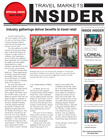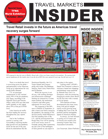Arrivals from Destination Canada’s international markets were up 5.8% year to-date through the first six months, with all 11 markets up year-over-year over the first half of 2017.
Destination Canada markets Canada internationally in Australia, Brazil, China, France, Germany, India, Japan, Mexico, South Korea, the UK and the USA.
More than 5.7 million overnight arrivals from the U.S. took place in Canada through June, up 3.1%. Year-to-date arrivals from the U.S. over the first half of the year were at their highest level since 2005.
U.S. overnight arrivals have positive year-over-year growth in auto (+5.8%), air (+8.7%), and other (+10.9%) arrivals.
Over the first half of 2017, Canada saw the highest proportion of U.S. overnight arrivals by vehicle originating from New York (18.5% of January-June U.S. auto arrivals), Washington (17.3%), and Michigan (12.1%), as well as Pennsylvania (4.8%), Ohio (4.7%), and Massachusetts (4.5%). Notable growth in cross-border traffic was also observed from several states further from the Canada-U.S. border – including Colorado, Georgia, Maryland, Texas, California, Oregon, Utah, and Virginia.
Destination Canada’s two Latin American markets, Mexico and Brazil, reached new record arrivals for the first six months of the year. Arrivals from Brazil were up 17% to 60,322. In line with the trend observed since the replacement of the visa requirement with the Electronic Travel Authority (eTA) in December 2016, Mexico continued to shine with year over year growth of +60.7% year-to-date to 169,769. Almost two-thirds of visitors from Mexico flew directly to Canada (63.9%), with nearly equal numbers also traveling via the U.S. either by air (18.8%) or by land (16.0%). Most visitors from Brazil arrived direct by air (55.8%) or via the U.S. by air (40.1%). Almost all direct air arrivals from Brazil landed at Toronto Pearson (YYZ) (93.6%), while those from Mexico usually arrived at either YYZ (47.2%) or Vancouver (YVR) (28.6%). There was a particularly sharp increase in direct arrivals from Mexico at Montreal (YUL) (+134.6%) as well as at YYZ (+95.9%) over the first half of 2017.
Year-to-date arrivals from all five Destination Canada Asia-Pacific markets were up by double-digits over the first half of the year. Arrivals from China were up 14.5% to 275,604.
Year-to-date in 2017, the majority of visitors from Destination Canada’s Asia-Pacific markets traveled to Canada by air directly from overseas. All markets except South Korea continued to observe declines in arrivals via the U.S. by land over the first half of 2017.
Year-to-date in 2017, arrivals from all three Destination Canada Europe markets continued to outperform the same period in 2016.
Ontario remained the most popular provincial entry point for international visitors to Canada over the first half of 2017, with approximately 47% of arrivals (4.01 million visitors) crossing the border there, up 8.4% over the first half of 2016.
Year-over-year growth in international arrivals was primarily concentrated in Ontario (+308,875 additional visitors), British Columbia (+94,618), Quebec (+67,039) and Alberta (+28,661).
In Ontario and Quebec this growth was apparent across overseas arrivals, U.S. auto and U.S. non-auto arrivals, whereas British Columbia and Alberta saw an increase in overseas and US non-auto arrivals outpacing slight declines in U.S. auto arrivals.
In the first half of 2017, overnight trips by Canadians to international destinations, including the U.S., were up a strong 5.4%, including +4.9% to the U.S. and +6.2% to overseas destinations.
Canadians took almost 9.5 million trips to the U.S. through June and 16,466,420 trips to all destinations including the United States.










